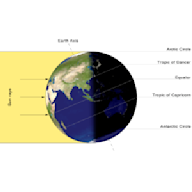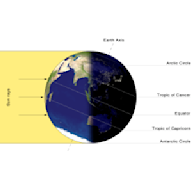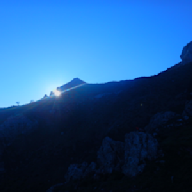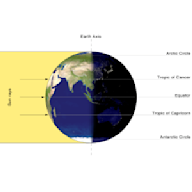Search results
Summer Solstice: The earth goes around the sun in an elliptical orbit. The nights are longer than the days of the winter season. This position of the earth is called as the summer solstice. Winter Solstice: On 22nd December, the Tropic of Capricorn gets direct rays of the sun as the South Pole tilts towards it. It is summer in Southern ...
The summer solstice occurs around June 21st in the Northern Hemisphere. It marks the longest day of the year, with the sun reaching its highest point in the sky. Solar Position: The sun is directly over the Tropic of Cancer (23.5°N latitude). Significance: Symbolizes the peak of summer and is often associated with various cultural festivals.
The summer solstice and winter solstice are two significant astronomical events that mark the change of seasons. Here are four key points regarding each: Summer Solstice. Definition: The summer solstice occurs around June 21 in the Northern Hemisphere, marking the longest day of the year when the sun is at its highest point in the sky.
Because of the difference in the tilt towards the axis, the phenomenon of experiencing the solstice occurs. But as earth is tilted, one hemisphere will be near the sun and one will be away from the sun at given point of time. So, logically there will be a difference in the timings of the summer solstice and winter solstice.
Many cultures have celebrations to mark the return of longer days and the coming of winter.Key Differences- Sunlight Duration: Summer solstice has the longest day, while winter solstice has the shortest day.-. Sun's Position: The Sun is higher in the sky during the summer solstice and lower during the winter solstice.-.
Which is the longest day and the shortest night in the southern hemisphere ? Watch Solstices & Equinoxes in Hindi from The Structure, Composition and Movement of Earth here. Watch all CBSE Class 5 to 12 Video Lectures here.
This tilt affects how sunlight reaches different parts of the Earth throughout the year, causing the seasons.Seasons and Solstices- Summer Solstice: In the Northern Hemisphere, the summer solstice occurs around June 21. This is when the North Pole is tilted closest to the Sun, resulting in the longest day of the year.-
Summer Solstice: - During the summer solstice, the Northern Hemisphere is tilted towards the sun and receives more direct sunlight. - The area between Equator and Tropic of Cancer receives more heat during this time as it is closer to the sun. - Hence, statement 1 is correct. Winter Solstice:
The Southern Hemisphere undergoes Winter and Summer Solstices at different times than the Northern Hemisphere due to the tilt of the Earth's axis. During the Northern Hemisphere's Summer Solstice, the North Pole is inclined toward the Sun, resulting in summer for the Northern Hemisphere. Simultaneously, the South Pole is tilted away from the ...
It is the northernmost point where the sun's rays can be directly overhead during the summer solstice in the Northern Hemisphere.Summer Solstice:The summer solstice is the day with the longest period of daylight in the year. It occurs around June 21st in the Northern Hemisphere and December 21st in the Southern Hemisphere.





